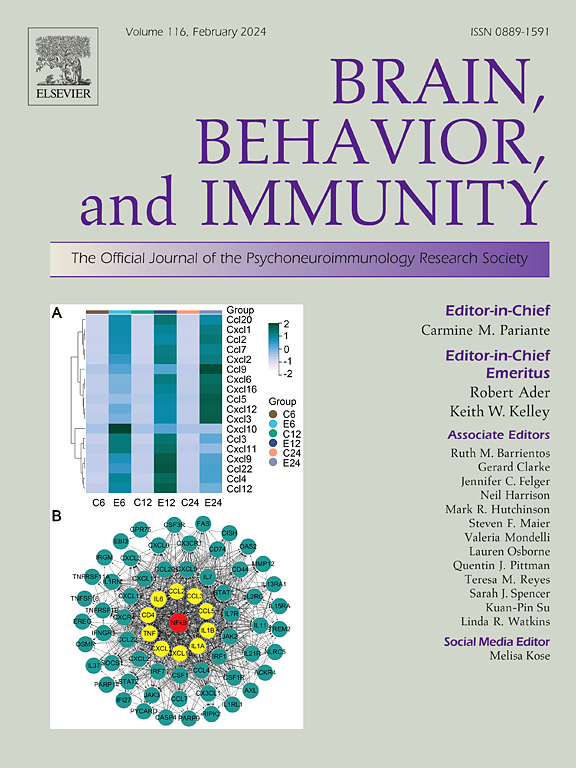PARP14 inhibits microglial activation via NNT to alleviate depressive-like behaviors in mice
IF 8.8
2区 医学
Q1 IMMUNOLOGY
引用次数: 0
Abstract
Microglial inflammation has been implicated in the pathophysiology of major depressive disorder; however, the underlying biological mechanisms remain inadequately understood. Consequently, we conducted a screening of the Poly ADP-ribose (PAR) polymerase (PARP) family expression in the hippocampus of chronic unpredictable stress (CUS) mouse models and investigated the specific role of PARP14 in microglial inflammation and its association with depression. Here, this study demonstrated the elevated PARP14 expression in the hippocampus of CUS mice. The knockdown of PARP14 in the hippocampus did not mitigate depressive-like behaviors in mice, whereas overexpression of PARP14 significantly mitigated these behaviors. Furthermore, PARP14 was abundant in microglia, and microglial-targeted PARP14 overexpression significantly alleviated depressive-behaviors in CUS, reduced microglial activation, and inhibited the central inflammatory responses. Mechanistically, PARP14 positively regulated nicotinamide nucleotide transhydrogenase (NNT) expression in microglia, and the inflammatory response of microglia induced by PARP14 knockdown was suppressed through NNT overexpression. Additionally, deficiency in NNT led to an accumulation of reactive oxygen species (ROS) and subsequent microglial inflammation, which was effectively inhibited by the ROS inhibitor N-Acetylcysteine. These findings suggest that PARP14 alleviates depressive-like behaviors in mice by inhibiting microglial activation via NTT-mediated clearance of ROS.
PARP14 通过 NNT 抑制小胶质细胞活化,减轻小鼠的抑郁样行为
本文章由计算机程序翻译,如有差异,请以英文原文为准。
求助全文
约1分钟内获得全文
求助全文
来源期刊
CiteScore
29.60
自引率
2.00%
发文量
290
审稿时长
28 days
期刊介绍:
Established in 1987, Brain, Behavior, and Immunity proudly serves as the official journal of the Psychoneuroimmunology Research Society (PNIRS). This pioneering journal is dedicated to publishing peer-reviewed basic, experimental, and clinical studies that explore the intricate interactions among behavioral, neural, endocrine, and immune systems in both humans and animals.
As an international and interdisciplinary platform, Brain, Behavior, and Immunity focuses on original research spanning neuroscience, immunology, integrative physiology, behavioral biology, psychiatry, psychology, and clinical medicine. The journal is inclusive of research conducted at various levels, including molecular, cellular, social, and whole organism perspectives. With a commitment to efficiency, the journal facilitates online submission and review, ensuring timely publication of experimental results. Manuscripts typically undergo peer review and are returned to authors within 30 days of submission. It's worth noting that Brain, Behavior, and Immunity, published eight times a year, does not impose submission fees or page charges, fostering an open and accessible platform for scientific discourse.

 求助内容:
求助内容: 应助结果提醒方式:
应助结果提醒方式:


